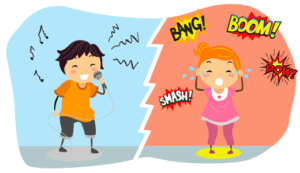Sensory Processing Disorder (SPD) occurs when a person’s sensory systems (visual, auditory, tactile, olfactory, gustatory, vestibular, and proprioceptive) are unable to effectively receive sensory information from the environment and process it to create an appropriate response. While Occupational Therapists (OTs) do not diagnose SPD, they are considered the experts in how sensory processing issues can impact a person’s ability to successfully participate in his/her daily activities.
If you or your OT suspect sensory processing issues may be impacting your child’s ability to engage in his/her desired activities your therapist will likely administer the Sensory Profile to gather more information about how your child processes sensory information. The Sensory Profile is an assessment tool that divides a person’s ability to process sensory information into four different styles. These styles are based on the strategies a person uses for self-regulation when provided with sensory information and whether a person has a high or low tolerance for different sensations. These four styles can help to better understand how sensory processing issues impact participation in daily activities.
Style 1: Sensory Seeking
What is it?: A high tolerance for sensory information and actively seeking out sensory experiences for improved self-regulation.
This child may appear: Busier and more engaged than others. Excitable or lacking safety awareness.
Parents and teachers might say: The child makes noise while working or may fidget and need to be constantly moving.
Activities this child might enjoy: These are children who love spinning, running, and crashing into things. They may also enjoy playing music, humming to themselves, or tapping their pencil or feet while working.
Strengths: Children who are sensory seeking often thrive when creating new games and activities. They are often active and continuously searching for new and exciting tasks.
Weaknesses: Children who are sensory seeking require intense environments filled with a variety of sensory experiences to keep them engaged. These children may become easily bored in environments with limited sensory stimuli and have difficulty sustaining attention on non-preferred tasks.
Style 2: Sensory Avoiding
What is it?: Low tolerance for sensory stimuli and actively seeking out environments with limited sensory information for improved self-regulation.
This child may appear: Disengaged, easily upset, anti-social, or shy.
Parents and teachers might say: The child is withdrawn, stubborn, or controlling.
Activities this child might enjoy: Solitary activities in environments with limited or easily controllable sensory stimuli, such as a bedroom with the door closed or a quiet section of the library or classroom.
Strengths: A child who is sensory avoiding will thrive when he/she is provided with routine and structure.
Weaknesses: A child who is sensory avoiding may lack a robust group of friends, or may become easily upset when plans change or his/her routine is altered.
Style 3: Sensory Sensitive
What is it?: Low tolerance for sensory stimuli and passively reacting to overwhelming environments. For example, experiencing an emotional breakdown when becoming over stimulated.
This child may appear: Cautious, overly focused on perfection, easily overwhelmed, sensitive, or emotional. This child may also have specific sensitivities that impact his/her ability to complete dressing, grooming, and meal-time tasks. Such as aversion to tags on clothing, the sound of a hair buzzer, or limited food preferences.
Parents and teachers might say: The child appears sensitive, emotional, or overly cautious.
Activities this child might enjoy: Finding and correcting errors, and activities that require a high level of attention to detail.
Strengths: Children who are sensory sensitive have high levels of awareness of the environment that results in a unique ability to attend to details.
Weaknesses: Because children who are sensory sensitive are acutely aware of small details they may become overly focused on perfection. It is important for parents to help manage the amount of sensory stimuli in the child’s environment so he/she is better able to proactively self-regulate.
Style 4: Low Registration
What is it?: High tolerance for sensory stimuli while passively reacting to sensory environments. For example, missing verbal or nonverbal cues from teachers or friends in an environment that lacks significant stimuli.
This child may appear: To have low energy levels, and appear as if he/she is frequently tired.
Parents and teachers might say: The child appears uninterested, apathetic, or self-absorbed.
Activities this child might enjoy: Activities that occur in environments with rich sensory experiences that will increase the child’s ability to attend and regulate.
Strengths: Children who are low registration are typically more flexible and are comfortable in a wide range of sensory environments, making them easy to be with.
Weaknesses: Children who are low registration require environments that are filled with sensory information to remain alert and attend to activities. Because of this, they may require additional cues to attend to the desired task or may need more time to complete tasks.
Conclusion
Sensory processing is a complex interaction that occurs between our bodies and the environments we interact with. It’s important to note issues with sensory processing are likely to impact multiple sensory systems in a variety of ways, meaning one person may display different sensory styles for different types of sensory information. For example, someone may be sensory seeking with movement, but sensory sensitive with touch. Talk to your OT if you have more questions about sensory processing and how it can impact participation in daily activities.
Contact Information
Contact Chicago Occupational Therapy or call (773) 980-0300 to learn more about our services and how we can help your child flourish and grow.
References:
Dunn, W. (2014). Sensory Profile 2 User’s Manual. Bloomington, MN: Pearson.




